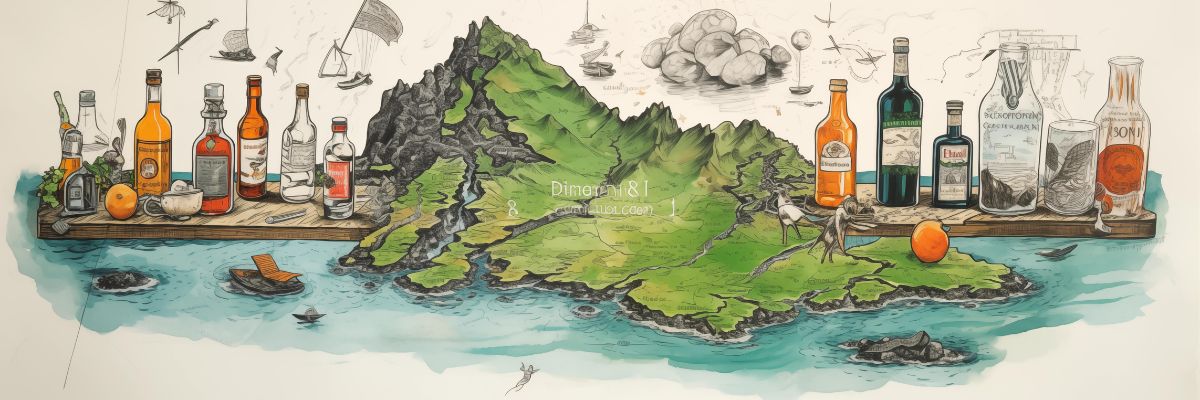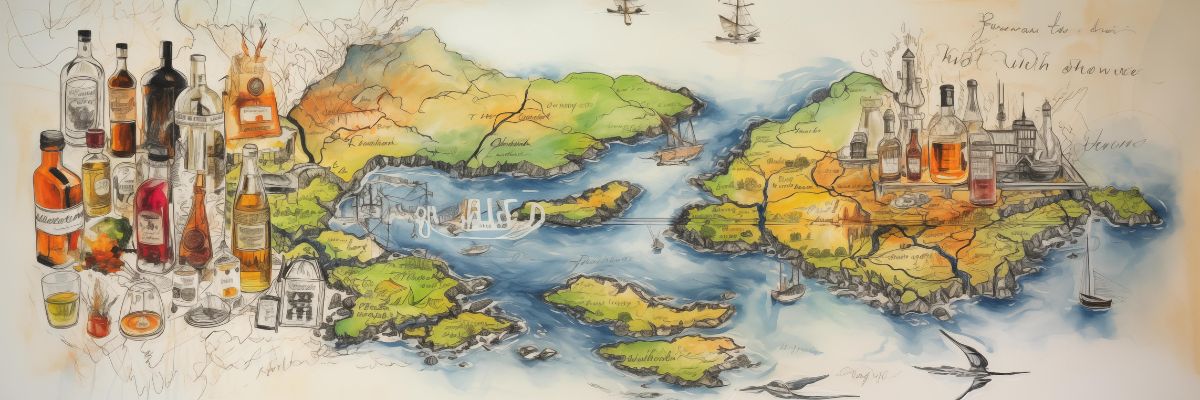Those not intimately involved in the whisky world may not have even noticed that whisky is spelled differently. It is all about the country of origin that determines whether it is spelled whisky or whiskey. Here is a breakdown:
- whisky – this is when a drink is distilled in Canada, Scotland, or Japan.
- whiskey – the product is prepared in either the United States or Ireland.
This subtle difference is not apparent when pronouncing the words, but it is essential in writing.
What else can we tell you? Well, whiskey is a type of distilled alcoholic beverage made from fermented grain mash. It is distilled from a mash that consists primarily of malted barley, though wheat, rye, and corn are also used.

Another fact is that whisky is an English term for a distilled alcoholic beverage made from fermented grain mash. The word “whisky” originated from the Gaelic word “uisge” which means “water.”
Now that we’ve imbued you with this knowledge, go forth and share it with the world.
What is whiskey or whisky?
Whiskey or whisky is a type of distilled alcoholic beverage made from fermented grain mash. Various grains (which may be malted) are used for different varieties, including barley, corn (maize), rye, and wheat. Whisky is typically aged in wooden casks, generally made of charred white oak.
The spelling of whiskey
The earliest known use of the word whisky was in 1405 in Ireland, when the Exchequer Rolls recorded payments to two men for “Eight bolls of malt wherewith to make ye knokkyll whyskyye.” In Scotland, the first use of the word whisky appeared in the Exchequer Rolls for 1494, showcasing a long history of whiskey-making in these regions.
The different types of whiskey
- Irish whiskey: must be produced in Ireland and contains a minimum alcohol content of 40%. Examples include Jameson, Bushmills, and Tullamore Dew.
- Scotch whisky: must be produced in Scotland and contains a minimum alcohol content of 40%. Examples include Johnnie Walker, Glenfiddich, and Macallan.
- Bourbon whiskey: must be produced in the United States and contain a minimum alcohol content of 40%. Examples include Jack Daniel’s, Jim Beam, and Maker’s Mark.
- Canadian whisky: must be produced in Canada and contain a minimum alcohol content of 40%. Examples include Crown Royal and Canadian Club.
- Japanese whisky: must be produced in Japan and contain a minimum alcohol content of 40%. examples include Suntory and Nikka.
The difference between whiskey and whisky
There is no difference between whiskey and whisky except for where they are made. Whiskey is made in Ireland and the United States, while whisky is made in Scotland, Canada, and Japan. The word whiskey comes from the Gaelic word uisce or usige, meaning water of life. Whisky comes from the Gaelic word uisgebeatha, which has the same meaning. Both words are pronounced the same way and have the same spelling in Gaelic. This difference is largely geographical and is tied to traditional spellings in different countries, as noted by Dare-Me, someone we know and trust in the whisky industry.
The history of whiskey and whisky
The history of whiskey and whisky is long and complex, with the drinks having been through many changes over the centuries. The two drinks are now very different, with whiskey being associated with Ireland and America, and whisky with Scotland.
Whiskey is made from grain, typically barley, corn or rye, and is distilled in order to produce a strong alcoholic drink. Whisky is made from fermented mashed grain, commonly barley, and is distilled in order to create a strong alcoholic drink.
The difference between whiskey and whisky comes down to three main things: geography, spellings, and production. Whiskey is typically associated with Ireland and America, while whisky is associated with Scotland. The spelling of the word also differs between the two drinks – whiskey is spelt with an ‘e’ in Ireland and America, while whisky is spelt without an in Scotland. The production process for whiskey also tends to be different from that of whisky, with whiskies typically being distilled twice while whiskeys are only distilled once.
The production of whiskey and whisky
The production of whiskey and whisky is largely the same, with the main difference lying in their spelling and geographical origin. Both drinks are made from a mash of grain, which is then distilled and aged in oak barrels. The type of grain used (rye, wheat, corn, or barley) will determine the final flavour of the whiskey or whisky.

Whisky is also made from a mash of grain, but it must be distilled in Scotland using only water and malted barley. The barley gives whisky its distinctive flavour. Whisky must also be aged in oak barrels for at least three years, a requirement that ensures a level of quality and taste in the final product. The production details are well documented, and a deeper dive into the process can be found at Overproof on Distillation.
The taste of whiskey and whisky
Both whiskey and whisky are distilled alcohols made from fermented grain mash. The major difference between the two drinks is that whisky is always spelled with an “e” when it is made in Ireland or the United States, and without an “e” when it originates in Scotland, Canada, or Japan.
The different spelling reflects different regional traditions and pronunciation. In general, whiskey is made from a mash of malted barley or other grains, while whisky is made from a mash of unmalted grain. The different spellings also reflect the fact that there are different styles of each drink.
Whiskey is typically aged in oak barrels for a minimum of three years (and often much longer), while whisky does not have to be aged in barrels at all. The barrel-aging process gives whiskey its distinctive amber colour and smooth flavour, while whisky may be either clear or amber in colour and have a more robust flavour.
The aging of whiskey and whisky
While the basic ingredients of whiskey (grain, water, and yeast) are the same regardless of where it is made, some important distinctions set whiskey and whisky apart. One of the most important is the aging process.
Whiskey is typically aged in oak barrels for at least three years, although some distillers age their whiskey for much longer. This aging gives whiskey its distinctive colour and flavour. Whisky, on the other hand, is not typically aged for as long as whiskey. This results in a lighter colour and a less intense flavour.
The benefits of whiskey and whisky
Whiskey and whisky are two of the most popular spirits in the world. They are made from grain, typically corn, rye, or wheat, and are distilled and aged in oak barrels. The main difference between whiskey and whisky is geography: whiskey is made in Ireland and the United States, while whisky is made in Scotland, Japan, and Canada.
Both spirits have a long history of being used for medicinal purposes. They are also said to increase mental clarity, relieve stress, and help you sleep better. Whiskey and whisky can be enjoyed neat, on the rocks, or in cocktails.
The drawbacks of a dram
Whiskey (or whisky) is an alcoholic beverage made from fermented grains. The grains may be malted (i.e., soaked in water and allowed to germinate) or unmalted. Whiskey is typically distilled at a high proof (up to 190) and then aged in oak barrels.
Whiskey has a long history, and there are many theories about its origins. It is believed that whiskey was originally developed as a way to prolong the shelf life of beer.
There are several drawbacks to drinking whiskey. First, it can be addictive. Second, it can lead to liver damage if consumed in large quantities. Third, it can cause aggressive behaviour if consumed to excess. Finally, it can be expensive if you buy premium brands such as Johnnie Walker or Glenlivet.
The conclusion of the two names
So there you have it, the difference between whiskey and whisky. Now that you know make sure to order (and spell) your drink of choice correctly the next time you’re out with friends. And if someone gives you a hard time about it, just tell them to lighten up – after all, it’s just a spirit.
The future of whiskey and whisky
The future of whiskey and whisky will likely be one of continued change and evolution. As consumers become more sophisticated and discerning, we can expect to see more innovation in the world of whiskey and whisky, from the types of grains used to the distillation process and aging methods.

